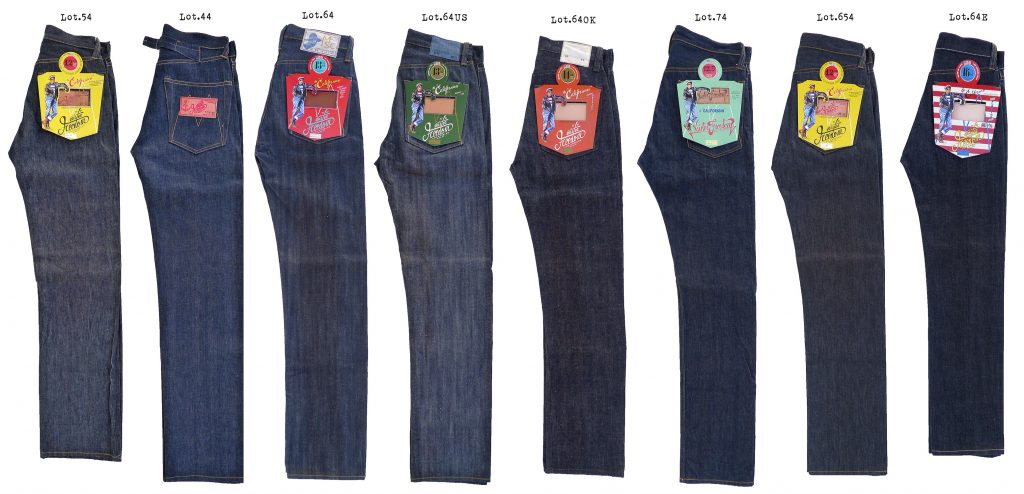



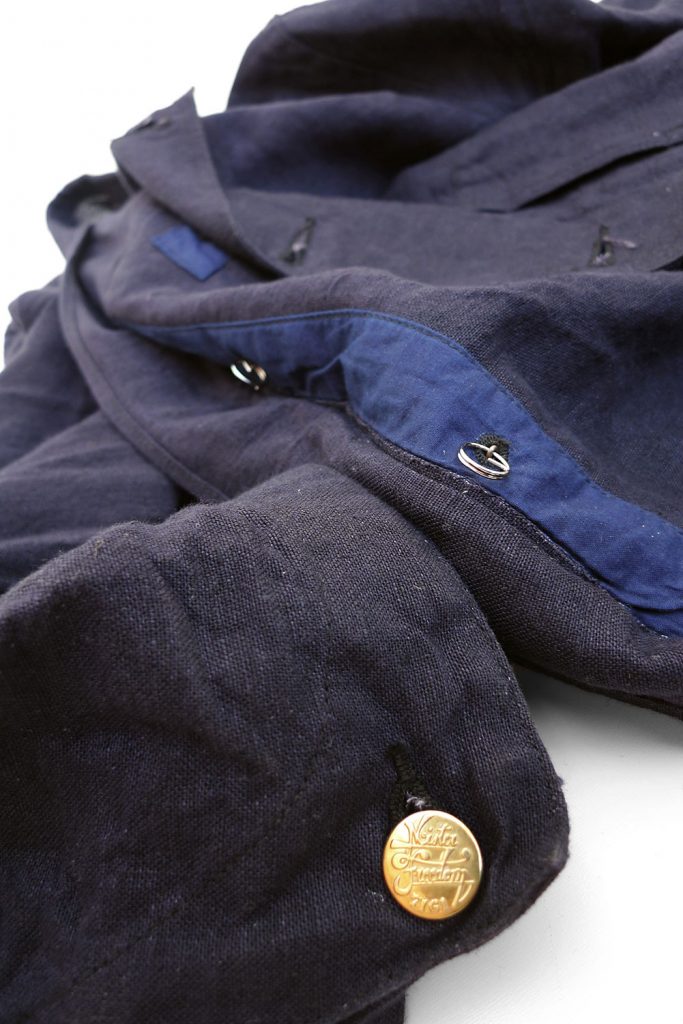


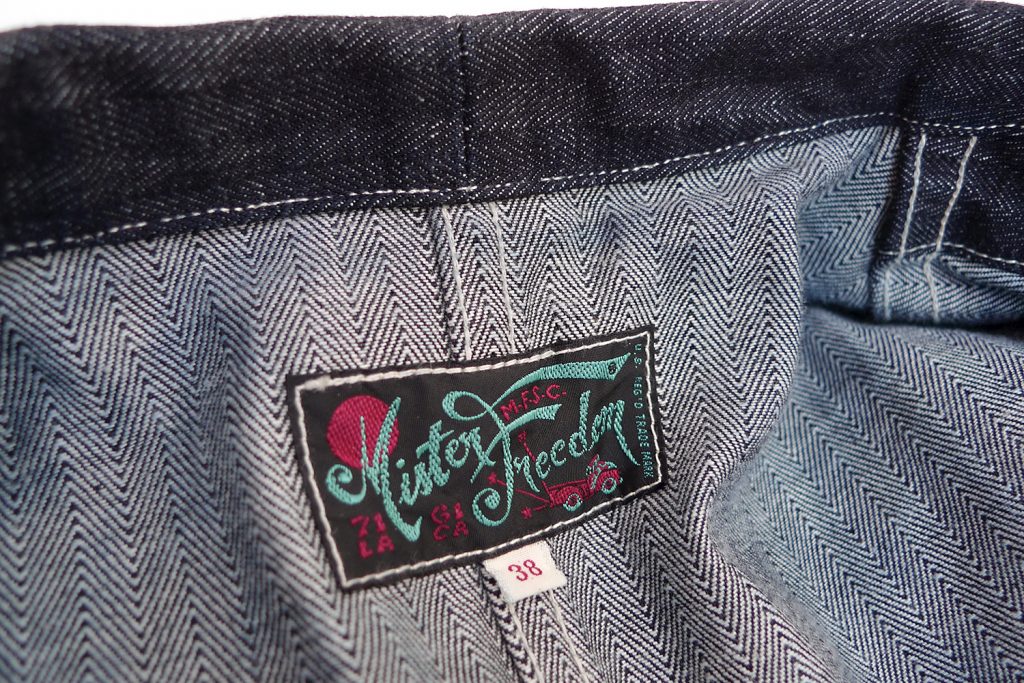
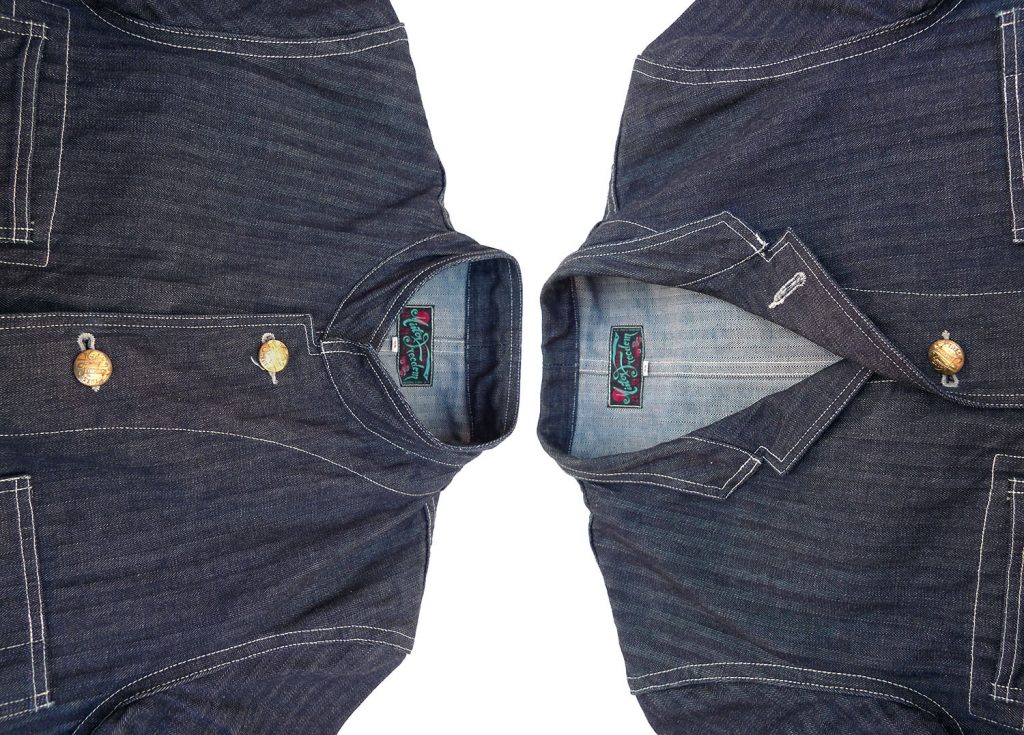



Mister Freedom® “McKARSTEN” Jacket, indigo métis & HBT denim.
SS2019 mfsc SURPLUS catalog.
Made in Japan.
The latest “might-have-been” we are adding to the Mister Freedom® x Sugar Cane Co mfsc Surplus catalog – our on-going collection of made-in Japan classics á la MF® – is the “McKARSTEN” jacket. The moniker is a reference to our beloved Peter Karsten, and workwear label Lakin & McKey‘s early days (founded in 1908, known today as Key Apparel.)
Our original pattern morphs several ill-fitting period garments into one wearable and contemporary piece with a vintage turn-of-the-century Old World vibe. The body of the McKarsten was inspired by a 1940’s medical field work cotton jacket made by “Nostrand Uniform Co“. The pockets were lifted from a 1930’s “TEST” chin-strap railroad jacket, aka chore coat or engineer jacket. The McKarsten features front panels with rounded bottom, cut longer than the split-back panel, and four patch pockets.
 Vintage inspiration of the SS2019 Mister Freedom® McKarsten jacket. This hybrid garment mixes utilitarian early workwear and old-fashion uniform tailoring. The removable “ring” buttons (or shank buttons) are characteristic of 1920’s-30’s uniforms, but also denim railroad jacket styles, much sought-after by vintage hunters today.
We had our version of these shank buttons custom-manufactured by our friends at Sugar Cane Co, using an obsolete pattern registered in 1913, featuring an octogonal-shaped back and a brass shell cap with original MF® branding. Removable buttons, often found on wool military tunics and work uniforms, were un-clipped and detached when the garment required cleaning. For military inspection, the metal buttons could be polished separately.
Besides the complicated construction of the garment button placket itself (look behind that attractive curved single stitch line around the collar, on the button eyelet hole side), the requirement of an eyelet-stitch machine for the manufacturer, buttons or rings would at times get lost. This fastening system proved quite impractical over time and was mostly abandoned by the 1950’s. Shank “ring” buttons are today a telltale of a desirable piece of costume history for the vintage clothing aficionado.
For the DIY-inclined, one can be creative, play around with colors and spray-paint our MF® brass buttons. Soaking them overnight in vinegar might hasten aging, but, with a bit of patience and wear, the brass buttons will naturally acquire an attractive patina overtime.
 Examples of DIY spray-painted original Mister Freedom® “ring” buttons for the McKarsten jacket ©2019 
The stand-collar or “cadet collar” pattern allows buttoning the McKarsten all the way up, for the “James Bond villain” meets Jawaharlal Nehru look. For a more relaxed demeanor, the collar can be folded into traditional coat lapels, with a high-button front jacket look.
We are realizing the McKARSTEN in two distinctive fabrics. One is a 10 Oz. HBT indigo denim. This fabric is what happens if you mill traditional indigo-dyed warp yarns and natural color weft yarns, into a woven herringbone twill pattern.
The second fabric option is a 7 Oz. blend of 75% linen and 25% cotton (referred to as métis in French), plain weave, indigo and black yarns, selvedge. This fabric was inspired by a 1920’s pair of French work pants, and milled with similar specs. Our version is very “breathy” and not tightly-woven, making it a great summer-weight fabric, with a somewhat see-through quality not uncommon on vintage tropical garb. The fabric drape and dry hand is typical of high-content linen métis.
The mfsc “McKARSTEN” jacket is designed in California by Mister Freedom® and manufactured in Japan by Sugar Cane Co.
FABRIC:
Two distinct fabric options:
a) A sturdy 10 Oz. HBT dark indigo denim, 100% cotton, milled in Japan. (Option featuring contrast stitching.)
b) An elegant 7 Oz. plain weave dark indigo métis, blend of 75% linen and 25% cotton, indigo warp and black weft yarns, solid white selvedge ID, milled in Japan. (Option featuring tonal stitching.)
SPECS:
* An original MF® pattern inspired by vintage early denim work chore coats (aka engineer jackets), early work uniform cotton jackets, and Old World tailoring.
* Stand-collar (“cadet collar”) type, foldable into traditional coat lapels, for a high-button jacket look.
* Removable “ring” (shank) buttons, secured by a metal ring through an eyelet.
* Original MF®-branded brass buttons, 1920’s style.
* Concealed indigo poplin facing for patch pockets, and for button eyelets panel placket.
* Four front patch pockets, featuring a traditional railroad jacket “pocket watch” compartment and pen slot combo.
* Uniform-style form-fitting rear panel pattern.
* Early tailoring style off-set shoulder yoke.
* Contrast stitching for the HBT denim option, tonal stitching for the indigo métis.
* Original mfsc SURPLUS woven label.
* Made in Japan.
SIZING/FIT:
Both options come raw/unwashed.
We recommend the usual initial 30mn cold soak/occasional hand agitation/spin dry/hang dry process. The tagged size reflects the size of the garment after going through this process. The subtle variation of shrinkage between body fabric/indigo poplin facing/cotton thread will result in puckering and roping, slightly altering the fit and drape.
The indigo métis version appears to be cut more generously than the HBT denim option, due to the lighter-weight fabric and totally different drape. Additionally, the métis loosely-woven fabric tends to naturally stretch back after the initial shrinkage.
I personally opted for a Size 38 in the HBT denim version, my usual size in mfsc jackets. The fit is quite comfortable, giving room for further potential shrinkage, when the garment will have to be fully laundered, and to minimal layering.
I went for a Size 36 in the indigo métis, as the 38 felt too roomy for my preference, especially after the mechanical stretch following a bit of wear. The arm opening of the 36 is snug but not uncomfortable when worn with a light shirt underneath.
When considering the length of the McKarsten, please note that the front panels are cut longer than the back panel, a characteristic of this early workwear jacket pattern.
Please refer to chart for approximate raw/soaked measurements. This explains how we size our garments.
Soaked = 30mn cold soak, spin dry and line dry.
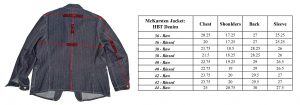 McKarsten HBT Denim  McKarsten Indigo Metis CARE:
We recommend removing the front brass buttons before cleaning (not the tack buttons of the sleeves!), to avoid potential snagging. When needed, machine wash the MF® McKARSTEN on DELICATE, cold water, mild eco-friendly detergent. Hang dry.
Wash separately to avoid color transfer to light-color garments. Turn the McKARSTEN jacket inside-out to avoid potential marbling of the indigo fabric.
Full wash cycle and heat dryer are not recommended and could damage the garment.
Sizes:
Small (36)
Medium (38)
Large (40)
X-Large (42)
XX-Large (44)
Available from www.misterfreedom.com, our Los Angeles brick & mortar store, and fine retailers around the World.
Email sales@misterfreedom.com or call 323-653-2014 with any questions unanswered above.
Thank you for your support.
Christophe Loiron
Mister Freedom®
©2019

 
   
Mister Freedom® Continental “RIVIERA” Two-Piece Suit (Sportcoat & Trousers).
Cotton-Linen Indigo Selvedge Chambray.
mfsc Sportsman catalog, Spring 2018
Made in USA
We have concocted this latest iteration of the Mister Freedom® “Continental” pattern with your next escapade to the Côte d’Azur in mind. Say bonjour to the elegant yet unpretentious, travel-friendly yet très chic Spring 2019 Continental “RIVIERA” two-piece suit.
Since its inception in early 2016, our Continental suiting concept – a casual unstructured sportcoat and trousers combo, all made-in-USA and today a staple of the Mister Freedom® SPORTSMAN catalog – has become a favorite for the International Man of Mystery who digs the re-bop, and the “FlipFlops and TankTop-Free Air Travel Club” frequent flyer.
After checking into your penthouse at Le Majestic, and as you enjoy the view of the bustling Croisette from the apartment’s balcony, unpack the RIVIERA suit rolled in your suitcase. Hang the set in the bathroom while showering, for a quick MacGyver-style steaming job. You are ready to head on over to the Promenade, for an invigorating stroll amongst rude locals and paparazzi.
The Spring 2019 release of the Continental, the “RIVIERA” edition set, comes in a luxurious chambray fabric, an old MF® favorite previously featured on the Naval Chinos Type No.266ic and the Breezer Type II.
This fine indigo selvedge chambray is a slubby, tightly-woven blend of 85% cotton and 15% linen, plain weave dark indigo warp with unbleached weft yarns, a dry and crispy-hand fabric flashing a white/red stripe selvedge ID, exclusively milled in Japan for mfsc.
Quite reminiscent of the 1950’s French Marine Nationale utility uniform fabric that had inspired our Sea Hunt ‘MN” Crew Pants (see original 2014 blog post), this chambray features a darker, reddish indigo hue, and a higher thread count than its naval counterpart.
Interestingly, chambray fabric, as it is known today, finds its roots in the city of Cambrai, Northern France, a busy textile hub since the Middle Ages. For centuries the region produced dyer’s woad and its industry was notorious for woolen cloth, woven linen and draperies. Cambrai became associated with fine linen Batiste or Cambric cloths, precursors of today’s popular chambray fabric.
The elegant fabric drape and classic texture of our cotton-linen chambray make it a perfect candidate for the MF® Continental suiting family. In popular culture, chambray fabric is often relegated to its blue prison workshirt status. But, just as duck canvas is not mere tent material, chambray is a noble textile, with endless applications in “heritage fashion”.
One might feel uncomfortable with the concept of a suit made of chambray, a cloth type often associated with shirting. But like denim twills, not all chambrays are created equal. They vary in weight, fiber content, color, thread count, finish, drape, Country of Origin, etc… The vintage clothing connoisseur will agree that the MF® RIVIERA cotton-linen indigo chambray perfectly qualifies as a classic summer suiting fabric.
For your mix & match pleasure, eclectic iterations of the Continental Sportcoat are already available in fine NOS fabrics such as an indigo crosshatch twill, two shades of grey cotton-linen twills, a light indigo “Player” denim, an elegant tropical “Congo Gabardine” cotton-linen twill, and a black pigment-coated “JC” denim twill. These can be paired with the Continental Trousers previously released in brown Cacao Chambray, indigo Crosshatch Denim Twill, light indigo “Player” Denim (aka Harlem Slim Special), and black-coated “JC” denim.
Bottom line, theMister Freedom® Continental “RIVIERA” indigo chambray edition is a solid, trust-worthy, low-maintenance travel companion and closet essential, when you need that extra dress-up touch at your destination, or when you just gotta TCB without the salaryman vibe.
Additionally, your indigo chambray suit is guaranteed to age gracefully over time. With normal wash/wear, the RIVIERA will acquire an attractive natural patina, the perks of well-made apparel cut from proper fabric and not factory-distressed. This is a sure way for MF® gear to retain high resale value on the international secondhand market, a fact that our hard-working MF® gang is quite proud about.
The “RIVIERA” is available as a matching Sportcoat/Trousers two-piece set, but also as individual pieces for a mix & match look.
The mfsc Continental “RIVIERA” Two-Piece Suit (Sportcoat & Trousers) in Cotton-Linen Indigo Chambray is designed in California by Mister Freedom® and manufactured in the USA in collaboration with Sugar Cane Co.
SPECS:
FABRIC:
A fine indigo selvedge chambray, a slubby, tightly-woven blend of 85% cotton and 15% linen, plain weave dark indigo warp with unbleached weft yarns, a dry and crispy hand fabric featuring a characteristic white/red stripe selvedge ID, milled Japan.
Pocket bags and waist band: Fancy New Old Stock 100% cotton woven stripe twill, Italian origin.
Continental “RIVIERA” SPORTCOAT:
* Unstructured silhouette.
* Lightweight and easily folded, perfect traveling companion.
* Late 50’s, early 60’s vibe high button front.
* Fabric selvedge concealed in the pocket construction.
* Tonal corozo wood butons.
* Half shoulder floating lining, 100% cotton NOS fancy woven stripe twill.
* Side hip pockets with flaps.
* Pocket openings reinforced on the inside with facing fabric.
* Tonal 100% cotton stitching, all clean caballo (chainstitch) flat-felled seam construction, green color “Sportsman” signature chainstitch on the inside. No open edges or overlock.
* Made in USA.
Continental “RIVIERA” TROUSERS:
* Elegant late 1950′s early 1960’s type silhouette and fit, straight leg.
* Tonal corozo wood fly and waist buttons.
* Fabric selvedge displayed on the leg split outer seam.
* Rear welt pockets.
* Trousers-style belt loops.
* Adjustable back cinch strap, with vintage NOS metal slide buckles.
* 100% cotton NOS fancy woven stripe twill pocket bags & waist band .
* NOS indigo twill fly/cinch facing.
* Watch pocket.
* Tonal stitching, 100% cotton thread construction, with inside green chainstich MF® signature.
* Original “The SPORTSMAN” woven rayon label on rear waistband, concealed when wearing a belt.
* Tailor shop-style unfinished overlocked leg bottom, to suit your cuffing preferences.
* Made in USA.
SIZING/FIT
This explains how we size our garments.
The “RIVIERA” Continental Sportcoat and trousers come raw/unwashed. We recommend the usual initial 30mn cold soak/occasional hand agitation/spin dry/hang dry process. The tagged size reflects the size of the garment after going through this process. The subtle variation of shrinkage between body fabric/lining fabric/cotton thread will result in puckering and roping, slightly altering the fit and drape.
I personally opted for a Size 38 in the Continental sportcoat and Waist 32 trousers. These are my usual sizes in the Continental series and most mfsc garments.
Due to the specific fabric drape of the indigo chambray, the Continental RIVIERA might feel a bit more generously-cut than its slim-fitting black-coated denim “JC” predecessor. This is more noticeable on the RIVIERA trousers, that tend to look like they feature a wider leg than previous Continental trousers, but feature very similar measurements.
Trousers sizing: The Continental Trousers are true to size. If you are a measured waist 32 inches, you are most-likely a tagged W32 in the RIVIERA Continental Trouser. Although we do not recommend sizing up on this RIVIERA edition, please note that the Continental Trousers pattern might not be a good option for all body types. Proportion-wise, those with very muscular legs will probably look better in our regular Sportsman Chino models.
Trousers hemming: After the initial soak/hang dry process, we recommend settling down on the final length of the bottom hem after gently wearing the trousers around the house a bit. The cotton fabric tends to naturally bunch/wrinkle and pull the leg up slightly. Letting this specific fabric react to your own body for an hour or so will allow you to decide on a proper classic leg break that works for you. I opted for a classic 1 1/4 fold, and subtle period flood.
Style-wise, consider avoiding bulky denim rolls, over-played BRMC cuffing and unsightly “stacked look” with these classic slacks. Look-up “traditional trouser break” for an old-school, adult silhouette.
Please refer to sizing chart for approximate raw/soaked measurements. Soaked = 30mn cold soak, spin dry and line dry.
(Fit pic: wearing a size 38 jacket and W32 trousers.)
 

CARE:
This unstructured cotton jacket and these trousers are low-maintenance garments, but should be treated with care.
When needed, machine wash the MF® Continental “RIVIERA” Sportcoat and trousers on DELICATE, cold water, mild eco-friendly detergent. Hang dry.
Wash separately to avoid potential color transfer.
Full wash cycle and heat dryer are not recommended and could damage the garment.
Continental “RIVIERA” SPORTCOAT:
Sizes:
Small (36)
Medium (38)
Large (40)
X-Large (42)
XX-Large (44)
Continental “RIVIERA” TROUSERS:
Sizes (Leg length about 36’’, left un-cuffed)
W 28
W 30
W 32
W 34
W 36
W 38
Continental “RIVIERA” Two-Piece Suit (Sportcoat + Trousers):
Available separately or as a two-piece suit (same fabric only, any size combination, rebate issued at PayPal check out.)
Available from www.misterfreedom.com, our Los Angeles brick & mortar store, and fine retailers around the World.
Email sales@misterfreedom.com or call 323-653-2014 with any questions unanswered above.
Thank you for your support.
Christophe Loiron
Mister Freedom®
©2019
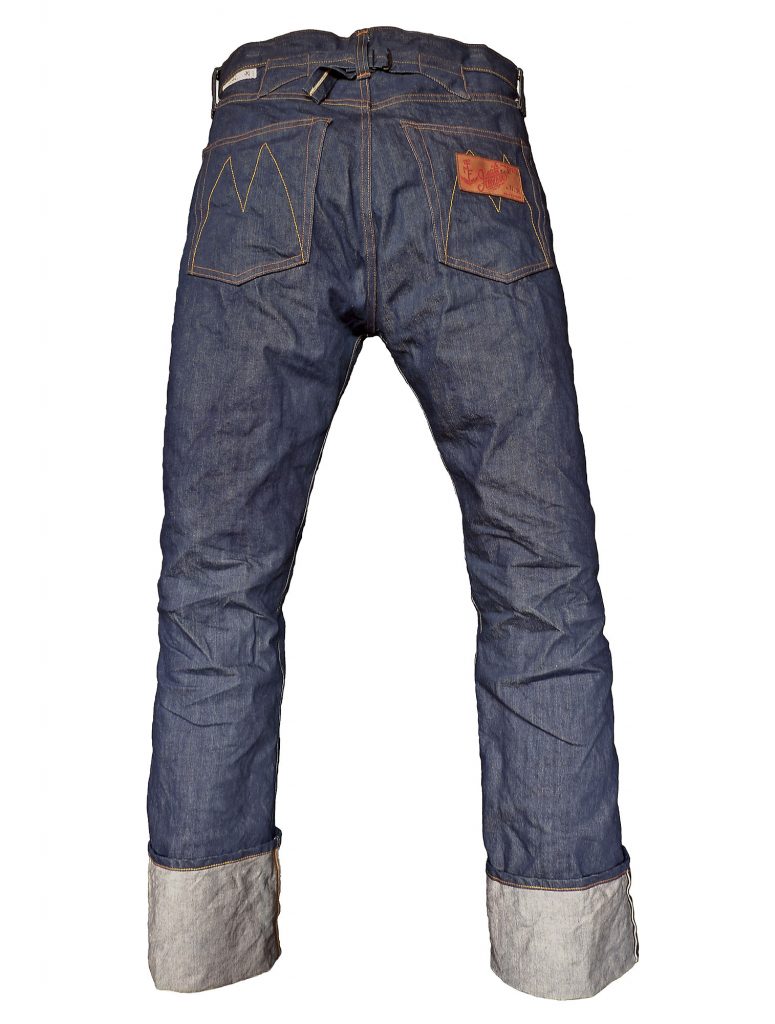





Mister Freedom® Californian indigo blue jeans Lot.44R (reissue)
13 Oz. selvedge denim twill, NOS Cone Mills.
mfsc Sportsman catalog.
Made in USA.
The Californian LOT.44 Blue Jean is our classic 1940’s-50’s silhouette, the widest fit of our straight leg five-pocket denim family.
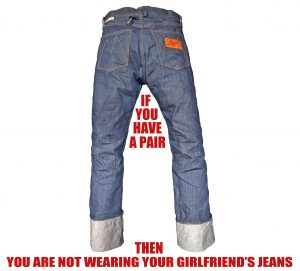 Tasteful 2012 promotion material. This special run revives the original popular pattern of the the LOT.44, with its old-school buckle back, higher rise and full leg. The “R” stands for “reissue”, as the LOT.44R are cut in one type of NOS denim, not a mixed bag of 37 twills as initially released back in 2011.
The New Old Stock fabric of the LOT.44R was milled by famed and now-defunct Cone Mills of Greensboro, N.C., USA. This handsome indigo denim twill is sanforized (will not shrink), and its selvedge ID is white with a red stripe .
The Californian LOT.44R were manufactured around 2016, and were, by oversight, never documented on the MF® blog, nor made available online. The webstore’s Californian section has now been updated with limited sizing of the LOT.44R..
The Mister Freedom® Lot.44R are designed and manufactured in California by Mister Freedom®, in collaboration with Sugar Cane Co.
Note: This release does not include the original MF® cardboard box packaging.
SPECS:
FABRIC:
New Old Stock Cone Mills (Greensboro, N.C., USA) 13 Oz. indigo twill denim, white with red stripe selvedge ID.
Pocket Bags: A fancy NOS 100% cotton herringbone twill, gunpowder grey color.
DETAILS:
* Classic vintage five-pocket pattern.
* Button fly.
* Original silver-color ‘oxidized’ MF® metal cast waist/fly buttons.
* Selvedge leg outseam.
* Buckle-back, aka cinch-back.
* New Old Stock fancy HBT cotton fabric pocket bags.
* MF® original yellow “M” stitch design on rear pockets.
* Hand-debossed natural veg-tan cowhide leather MF® patch on rear pocket.
* Twelve types of 100% cotton threads (gauge and color combination) used for construction. Main colors are yellow and orange, with white accents.
* Coin pocket.
* Selvedge button hole fly placket.
* Hidden back pocket reinforcement rivets, with top pocket reinforcement zig-zag stitching.
* Lined rear pockets (NOS grey HBT cotton.)
* Unmarked copper riveting for pocket opening reinforcement.
* Packaging-free.
* Made in USA.
SIZING/FIT:
This NOS denim is sanforized, i.e. the LOT.44R Californian will not shrink after the initial recommended 30mn cold soak, spin dry and line dry.
They are true-to size, and a tagged W32 measures approximately 32 inches.
The LOT.44R feature a straight leg with a generous silhouette and a higher rise, with a definite 1940’s-50’s “period vibe”.
NOTE: We measure the waist of our jeans by doing the following:
1) Fasten the top waist button.
2) Pinch both ends of the folded waistband firmly, pulling reasonably so that front rise and back rise align and lay flat.
3) Position the straight folded waistband on a (fixed) wooden measuring stick (cloth tape tends to stretch overtime, giving wrong measurements.)
4) Read the measurement then double it.
Ex: a 16 inches measurement across the waistband becomes a Waist 32.
Refer to our sizing chart for raw/cold soaked measurements.
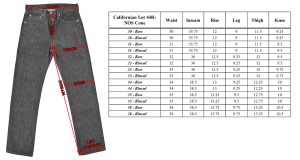
The Mister Freedom® “CALIFORNIAN” Lot.44 is available RAW/unwashed.
Available tagged Sizes:
W30 × L34
W31 × L36
W32 × L36
W33 × L36
W34 × L36
W36 × L36
W38 × L36
Now available from www.misterfreedom.com, and our Los Angeles brick & mortar store.
Email sales@misterfreedom.com or call 323-653-2014 with any questions unanswered above.
Note: These are not issued with the original MF® cardboard box.
Thank you for your support,
Christophe Loiron
Mister Freedom®
©2019







Mister Freedom® “G.I.” Two-Button Shirt, NOS indigo cotton Fisherman’s rib stitch jersey knit.
“The Sportsman” catalog, Fall 2018.
Made in USA.
In true Mister Freedom® fashion, we will “render unto Caesar the things that are Caesar’s” and duly credit Uncle Sam for the pattern of this garment, as we shamelessly lifted this “henley” shirt design from a US Government-issued cold weather classic from the 1950’s. Initially released under the “Undershirt, Winter, M1950” moniker, it is sometimes referred to as the “Wallace Beery” shirt.
The M-50 (model 1950) was adopted by the U.S. Army QMC in 1948, and, starting in 1950, a set of three shirts was issued to American soldiers heading out to Korean battlefields.
We are all familiar with the original military version, the unbleached wool merino-cotton blend knit shirt with the two large white buttons, and its superseding brown 436 issue, both quite a staple of old-school Army/Navy surplus stores.
-

-
Original vintage US Army M-50 undershirt.
-

Following our typical modus operandi, we decided to “civilianize” this classic US Army undershirt. For a fashionable make-over, we tapped into the final precious yardages of New Old Stock indigo cotton jersey, the handsome deep dark indigo blue yarn-dyed 100% cotton “Fisherman’s rib stitch” jersey knit, milled in USA, previously featured on the MF® Chandail Saint-Malo. The technical knitting term “Fisherman’s rib stitch” refers to the fabric’s specific weave, displaying a vertical pattern of fine ribs, with somewhat of a ‘waffle’ aspect reminiscent of vintage thermal shirts.
For the button placket, departing from the original M-50 military design with its simple matching knit placket, we decided to spice things up with extra indigo goodness. Although not quite visually noticeable at first glance, the placket is cut from a contrasting NOS plain-weave fabric, of an almost matching dark indigo color. This not only makes the button front closure sturdier than the loose-weave jersey, but also creates an attractive subtle contrast in both texture and color, promising of an interesting patina down the line.
Like the military original, our “GI” indigo shirt features the characteristic utilitarian flatlock stitch overall construction, the stretch-resistant reverse weave top shoulder gusset, the unusual inverted top seam arm stitching, the wide self-fabric cuffs, and the two ‘oversized’ cat-eyes buttons. We opted for fancy corozo wood for our version, in a complimenting rich amber brown color.
Just like with the production of the Saint-Malo, the specific horizontal mechanical stretch combined with fabric shrinkage made manufacturing the GI shirt a tour de force for our local factory. It took nearly one year of challenging sample-making and pattern-adjusting to get the fit, stitching and proportions right. After all that R&D challenge, we are quite ecstatic to finally add this little guy to the ever-growing MF® Sportsman catalog.
Style-wise, our “G.I.” Two-Button Shirt is quite versatile and can be worn as a thermal-type undershirt, as a single-layer shirt, as a light sweater over a summer-weight button shirt, like a Nixon chambray for instance. Tucked-in old-man style to compliment the classic wedgie look dear to our model, or untucked, for the younger crowd.
As always, our shirt is not available factory distressed. The subtle and attractive heather quality of the deep dark indigo will intensify as the garment fades with normal wear/wash cycles. See photos featuring a well-worn and frequently-washed early prototype, next to the freshly-issued version, for the rewarding results of naturally faded habiliment.
It is the nature of deep tone indigo-dyed garments to transfer some of the indigo blue color to other surfaces, from abrasion. The MF® GI Two-Button shirt is a real bleeder, both from the knit and woven fabric parts. On a side note, this is probably the reason why this fabric was never cut into garments, and ended-up as New Old Stock, to our delight. To avoid the soup sandwich of complains and merchandise returns, a (mystery) brand responsible for having milled this amazing indigo knit jersey likely cancelled whatever project they had with it, after realizing everyone’s hands were turning blue…
Well, we picked up where they left off, and happily played with their unwanted toy! One of the perks of being part of a small independent label, is the reassurance of a bright, responsible, adult audience, such as the one we have been cultivating for the past 12 or so years. We are so indebted to our customers for the opportunity and privilege to design all sorts of challenging, eclectic, offbeat wearables, seasons after seasons, sustainably and regardless of trends. Thank you all, Mister Freedom® ❤️ you!
CAVEAT EMPTOR: Although the indigo connoisseur will relish in the deep dark tone, the MF® “G.I.” shirt might not be an ideal garment for the faint-hearted or laundry-challenged. Indigo crocking will perdure even after several wear/wash cycles. I’ve had a blue torso from wearing mine without an undershirt! The shirt’s indigo blue will definitely rub-off on light-color garments, sofas, car seats, walls, skin, etc… Color transfer should easily wash-off with regular laundry methods, but we definitely recommend not wearing white undershirts, white shirts or white jackets with this garment for a while.
Indigo color transfer will eventually subside after about 10 wear/wash cycles, and the knit fabric settle to a beautiful typical indigo hue.
The MF® G.I. Two-Button Shirt is designed in California by Mister Freedom®, and manufactured in USA, from American NOS fabric.
FABRIC:
New Old Stock 100% cotton “Fisherman’s rib stitch” jersey knit, deep dark indigo blue yarn-dyed, milled in USA.
Note: Although not overly light-sensitive, expect substantial color crocking with this specific indigo knit fabric. It is the nature of indigo-dyed garments to transfer some of the indigo color to other surfaces, from abrasion.
SPECS:
* An original MF® pattern inspired by vintage 1950’s Government-issued US Army M1950 two-button front cold weather undershirts.
* Utilitarian flatlock stitch overall construction.
* Corozo wood buttons.
* Contrasting indigo-dyed plain-weave fabric button placket.
* Stretch-resistant reverse weave top shoulder gusset.
* Wide self-fabric cuffs.
* Inverted top seam arm stitching.
* MF® Sportsman trademark contrasting green inside stitching.
* MF® Sportsman woven label.
* Made in USA.
SIZING/FIT:
After an initial cold rinse and heat dry cycle, the MF® G.I. Two-Button Shirt will fit pretty much like our popular Stanley T-Shirt, but with much more ‘elasticity’ (mechanical stretch). If you are familiar with our Skivvy and Stanley T-Shirts, our Tricot Marin fits like a Skivvy, while our GI shirt feels more like the Stanley, due to similar fabric stretch properties.
I wear a Small in Stanley and Skivvy, and usually Medium in mfsc button shirts. I opted for a size Small in the GI shirt, with a snug initial fit that loosened-up gradually while wearing the shirt. After a day of normal wear, the shirt’s body expands a few inches in width, minimally in length. If the pattern has been specifically adjusted to avoid an unattractive “boxy” silhouette, a Small in the AM feels somewhat like a Medium in the PM.
Basically, the GI shirt will shrink to a tighter fit after laundering/heat dry, but easily expand again with wear as the knit fabric loosens up.
If you are in-between sizes, or worried about an overly-relaxed fit, we recommend sizing down on the GI shirt. As always, which size will work for you depends on your own aesthetics, body type, preference for ‘vintage’ silhouette or contemporary fit.
Refer to sizing chart for measurements, taken with the item laying flat and NOT stretched. Do keep in mind the mechanical stretch aforementioned, and expect the shirt to gain an inch or two in width as it is worn and naturally stretched over the torso.

 Mister Freedom® GI Two-Button Shirt, size SMALL (washed/dry). CARE:
We recommend cold wash with eco-friendly detergent, heat dryer. Wash and dry separately to avoid color transfer to light color garments.
DISCLAIMER: Beware that this indigo garment will ‘bleed’ through several wash/wear cycles, and color transfer will occur on other garments, furniture, car seats, skin, washing machine and heat-dryer drums. It is the nature of indigo-dyed garments to transfer some of the indigo color to other surfaces, from abrasion.
This indigo color transfer will eventually subside after about 10-15 wear/wash cycles.
Available raw (un-washed)
Sizes
X-Small
Small
Medium
Large
X-Large
Available from www.misterfreedom.com, our Los Angeles brick & mortar store, and fine retailers around the World.
Email sales@misterfreedom.com or call 323-653-2014 with any questions unanswered above.
Thank you for your support.
Christophe Loiron
Mister Freedom®
©2018
   




 

 Mister Freedom® “Lawrence” Jacket, Caravan A.  Mister Freedom® “Lawrence” Jacket, Caravan B.  Mister Freedom® “Lawrence” Jacket, Caravan C.  Mister Freedom® “Lawrence” Jacket, Caravan D.  Mister Freedom® “Lawrence” Jacket, Caravan E.  Mister Freedom® “Lawrence” Jacket, Caravan F.  Mister Freedom® “Lawrence” Jacket, Caravan G.  Mister Freedom® “Lawrence” Jacket, Caravan H.
Mister Freedom® “LAWRENCE” Jacket, up-cycled antique Kilim rugs/blankets.
FW2018 Limited Edition.
Made in USA.
For this glorious season, we concocted a special one-of-a-kind rendition of the Mister Freedom® Baloo jacket, the furry little number we had introduced last Fall. The Baloo, our interpretation of the popular 1930’s “grizzly” type leather coats, and a bear necessity for the classic leather jacket connoisseur today, got back to the drafting table for a new wacky spin à la MF®.
We are calling this Fall 2018 garment the “LAWRENCE”, a reference to the wild Arabian adventures of famed British archeologist, camel-riding diplomat, khanjar-toting gentleman, gone-native Army Captain, Thomas Edward Lawrence.
Having watched Lawrence of Arabia‘s exciting silver screen saga one-time-too-many (cue-in Maurice Jarre’s haunting score), someone at the office had the balmy idea of spicing-up the ol’ MF® Baloo pattern with a dash of exotic oriental flavors!
Taking the usual MF® liberties with geography, cultural authenticity, historical accuracy and common sense, it was decided to blend antique oriental textiles with our classic leather jacket. By incorporating into our USA-made Baloo pattern a mixed bag of vintage rugs or blankets out of the “Rug Belt” (think bygone Persian and Ottoman Empires, the Middle East and South Asia), our plan was to deliver a somewhat plausible local souvenir that ‘Aurens could have brought home from his tumultuous epic travels, a custom-made jacket to go ride his Brough Superior around, Bedouin-style, back in the peaceful English countryside.
Now, this one is for the social media… The following exchange allegedly took place on a distant shore of the Red Sea, sometime in 1917, as reported by a reliable source claiming to be present at the time. This bizarre bazaar encounter is not a well-documented episode, and although its accuracy will fiercely be debated on 4chan in the coming years, historians we consulted have all confirmed it with an eye roll. So, do quote us on it, and remember where you heard it here first. This is how it was relayed to the MF® Editorial Dept., verbatim:
Souk merchant: “Yalla, English! I have nice jacket for you, souvenir from Aqaba! Has your name written on it, wallah!”
T.E. Lawrence: “Nothing is written, my good lad. Oh… wait… dude! That’s one funky fresh jacket!!”
Souk merchant: “Shukran ‘Aurens, I knew you’d dig it, habib! Toldja, mektoub! Now, paper or plastic?”
(?)
 “Yep, that’s pretty much how it happened.” Words unpronounced by T.E. Lawrence & Lowell Thomas, London, 1918 (Image ©Marist College) Above photo of “T.E. Lawrence & Lowell Thomas sit in London session portraits” 1918 courtesy of ©Marist Archives, in accurate historical context here.
In regards to style, the following statement might make anthropology textile experts cringe (they probably already left this page realizing we’re about to chop-off collectibles to turn them into “fashion” items anyways), but an amateur might point out visual similarity between certain Kilim traditional patterns and some of their hand-woven Native American counterparts. For the profane (that’s us), geometric symbolism such as tribal stripes, the famous Eye-Dazzler pattern, diamonds, stars, running water, or multicolor Anatolian Manastir motifs, do bring to mind works of early and contemporary Navajo or Pueblo weavers, and other skilled loom artists who contributed to the production of rugs and blankets of the American Southwest. The commun thread, we believe, is that commercially-produced traditional crafts of a specific ethnic group will inevitably evolve with outside demand, bartering, raw material and dye imports, foreign tastes and eventual cultural assimilation. Similar designs and symbols appear along trade routes, distant styles end-up overlapping, making cultural authenticity somewhat of a subjective concept with artisanal handicraft. So, expect an occasional “awesome Indian blanket jacket, dude!” comment, while sporting your MF® Lawrence.
After this colorful ouverture, and rather than sharing an uneducated opinion on current Arab affairs and oil barrel prices, here are a few highlights of our own saga with the MF® “Lawrence” production, for the insomniac few.
As often with USA-made projects we embark on, comes the moment we all look at each others at the HQ, with the same puzzling question: “Who the *%$#&* thought that was a good idea?” Even our intrepid MF® R&D Department expressed doubts during manufacturing…
First, we had to source the full grain veg-tan leather hides, all inspected one by one for grain, overall quality and feel. This is the same grade of leather we have been using since 2013 for the MF® Campus, and its Baloo successor. The hides are very light sensitive and initially almost ivory white, until exposed to natural daylight. The leather gradually sun-tans to a pinkish hue, eventually developing attractive golden tones.
Then, Hut, Hut, Hut, off we went on a hunting safari for vintage rugs!
We found a local Ali baba’s cave, the vault of a Pakistan-born textile expert, a gentleman specialized in legally-imported, well-documented antique oriental rugs. Going through dozens and dozens of stacked-up specimen, we focused on flat-woven Kilim rugs of the non-pile (flat weave) and non-slit family (no “openings” in the weave.) We carefully selected candidates from the first half of the 20th Century that aesthetically and technically qualified for the project. Each rug was hand-picked for its attractive geometric motifs, vintage appeal, fine color combination, unique hand-woven imperfections, occasional period hand-repairs and overall natural patina. These are woven from wool and cotton yarns, dyed in unstable, non-colorfast natural dyes, often leading to subtle color runs. This is part of their wabi-sabi charm, and the uniqueness separates them from Ikea’s versions. The kilim expert mentioned that, back home, these rugs served as wall-hanging decoration, blankets, home carpets, camel saddle covers…
Considering the latter, we took our loot to a professional cleaning facility specialized in antique rugs, an impressive old-school operation established in Los Angeles in 1926, a recommendation from our friend Channon at In The Field. We had each rug thoroughly hand-brushed, hand-washed and sun-dried, without the use of machines, quite a costly procedure, almost doubling the cost of each vintage piece!
Came the time to unroll the freshly-clean rugs back in our atelier, and figure-out how to turn them into front panels of jackets… To strategically cut according to each rug design, while trying to envision each finished jacket with well-balanced panels, we thought of making our pattern paper out of clear PVC.
It soon hit us that there is nothing remotely symmetrical in a nomadic tribal rug, hand-woven on an horizontal floor loom, somewhere in a remote mountainous region of Pakistan, some 80 years ago. Eye-balling seems to be the golden rule in metrology for the Rug Belt artisans.
After a few hours of deliberation, positioning and repositioning the pattern markers, we traced panels on each rug, combining sizes and grain direction. We then painstakingly fused the panels with high-quality woven cotton fusing, using an industrial steam iron. We, of course, chose to do this during the hottest months of summer, to fully embrace the benefits of facial steaming.
Each panel was then cut using electric shears, somewhat of a liberating experience, and carefully overlocked to avoid later fraying of the edges.
After completing this portion of the hands-on production, we resumed our water-skiing activities and badminton tournaments. The MF® atelier’s contribution was temporarily over! The jackets themselves, however, still had to get made…
We happily passed the hot potato to a local facility, who, in-turn, couldn’t wait to throw it back at us. The factory’s expert craftsmen had never worked on such a “fun” project, involving new leather and eclectic vintage textiles. Most places would have turned us down, so we are indebted to our small manufacturing source for accepting the challenge. After a few months of intricate and complicated assembly work, production management headaches and anxious back-and-forth, our Lawrence Jackets were ready! Ready, that is, for the final touch back at the MF® HQ: hand-sewing hundreds of corozo double buttons, which gets old after about five.
We are, many months later, proud to announce our one-of-a-kind and once-in-a-lifetime MF® “LAWRENCE” jackets! We hope you enjoy the finished product as much as we got our kicks during the manufacturing fantasia!
 The Mister Freedom® “Lawrence” Jacket saga ©2018 As one will guess from the making-of collage, the yield (number of panels per rug), selection of sizes cut per rug, and geometric design variations per panel within each rug, all got out of control pretty quick. We had realized early-on that no-two jackets were going to be the same, making the MF® Product Photography Department quiver in anticipation of this post.
For inventory purposes, we have regrouped the MF® Lawrence jackets in eight families (called them caravans), according to the specific vintage Kilim rug they were cut from (Caravan A, B, C, D, E, F, G, or H). Not every rug yielded a full size scale, and availability of the MF® Lawrence jacket will be limited to this FW2018 batch.
DISCLAIMER:
* VEG-TAN LEATHER: The Mister Freedom® Lawrence Jacket is cut from genuine leather. We use full-grain, and not “top-grain” leather (aka corrected or buffed leather, sanded to level surface inconsistencies). No two hides are alike and each panel may feature variations in texture along with natural imperfections.
* The occasional nicks and marks on the hides we select are characteristic of pasture-raised cattle, with the implication of natural scarring from roaming and being in contact with other animals. Considering the obvious perks of outside grazing for the cattle, vs. confined indoors or in pens as required for the production of some luxury leather goods, we find these natural imperfections to be perfectly acceptable, if not a desirable trait of a Mister Freedom® leather garment. These “life” marks are inherent to full grain leather, and will blend into a natural patina when our jacket is worn, conditioned and lived-in.
* Early signs of tanning of panels may, at times, be visible on a finished garment, as we pay premium to have our leather goods produced in a pleasant, well-lit, clean and ethically-run California facility. We’ll leave the dark, un-safe, regulation-evading basements where less-fortunate workers toil, to less-regarding fast-fashion labels catering to the modern consumer’s insatiable appetite for “affordable” disposable goods. In other words, we do not consider a new jacket with partially-suntanned panels a defective garment.
* RECYCLED KILIM RUGS: The front panels feature genuine vintage kilim rugs/blankets that are about 70 to 90 years old. These can show signs of wear and natural patina, color fading and crocking, woven imperfections and unevenness, design pattern asymmetry and occasional rugged hand repairs. Due to Mister Freedom®’s background in vintage clothing, we consider these imperfections desirable. These natural flaws are inherent to up-cycling projects, such as turning antique textiles into new unique garments, still fit as wearables for next generations.
Thank you for your understanding.
The MF® LAWRENCE Jacket is designed by Mister Freedom® and manufactured in USA, from USA-sourced hides and up-cycled genuine vintage Oriental rugs of the Kilim family.
SPECS:
PATTERN:
Inspired by 1930’s “Grizzly” type leather jackets, and other vintage American sportswear and outdoor garments, and somewhat by the 1962 film “Lawrence of Arabia”.
The original MF® Lawrence jacket pattern is adapted from our MF® Baloo jacket pattern, in turn adapted from the MF® Campus jacket.
MATERIALS:
* Shell: Vegetable tanned leather, full grain cowhide, milled and supple, natural finish and color, about 2-3 Oz weight, sourced in USA.
* Front panels: Up-cycled vintage Oriental rugs of the Kilim family, with a probable provenance in Pakistan and surrounding regions.
* Lining: 100% cotton brushed flannel with a 1940’s-50’s-inspired vibrant plaid pattern, discharge-printed. Fabric milled in Japan.
DETAILS:
* Vintage 1930’s style, inspired by cossack-type and Grizzly-type panel leather jackets.
* Fully lined with a soft cotton brushed flannel featuring a vintage style discharge-printed plaid pattern.
* Front panels cut from a vintage genuine Oriental Kilim rug.
* Full single panel veg-tan leather back.
* Slash pockets with arrow-head pocket stops.
* Side gussets with adjustable side straps (NOS metal slide buckles)
* Keyhole button holes.
* Corozo ‘Cat Eyes’ wood buttons, backed by vintage-style corozo wood “cat-eyes” buttons.
* Mister Freedom® woven “Sportsman” label.
* American-sourced hides.
* Limited Edition. Each jacket is a one-of-a-kind collectible.
* Made in USA.
SIZING:
The MF® LAWRENCE Jacket is true to size. I am usually a 38 in mfsc jackets and opted for a 38 in the MF® LAWRENCE, with enough room for a lightweight layer underneath.
The fit is relatively snug, so we do not advise sizing-down on this garment if you are in-between sizes. If planning on layering with heavy cable knit wool sweaters, consider sizing up in order to be able to comfortably button-up the jacket.
Refer to sizing chart below for approximate measurements. Please consider the thickness of the leather/Kilim/lining when trying to match your chest measurements and the jacket’s measurements. If still in doubt, please contact sales@misterfreedom.com with your specifics for recommendations.
CHART
CARE:
We recommend wearing the jacket as-is. No specific initial conditioning or pre-treatment is required. Just wear and enjoy witnessing the natural ageing and patina evolution.
According to frequency of wear and exposure to the elements, some light conditioning might be applied to the sleeves after months of continuous wear, using products similar to Pecard Antique Leather Care. Be aware that conditioning will darken the leather, and should only be applied with care and expertise.
* Do not dry clean. Even professional leather cleaning facilities might not be competent on how to treat the specific LAWRENCE jacket veg-tan leather/woolen woven rug/cotton lining combo.
* Do not use heavily-oily products designed for footwear, such as neatsfoot oil.
* Do not attempt to “wash” the Kilim woven panels. Use a dry, plastic bristle brush for cleaning if needed.
* Should leather parts of your jacket get accidentally stained from normal wear, consider this a normal stage of the evolution of an outdoor garment. As often witnessed on well-worn vintage leather jackets, wear, stains and scratches will eventually blend-in into the most attractive and unique patinas.
Available NATURAL.
Sizes
36 (Small)
38 (Medium)
40 (Large)
42 (XLarge)
44 (XXLarge)
Front panel styles/patterns: regrouped in eight kilim families/caravans: A, B, C, D, E, F, G, or H.
Not every rug yielded a full size scale, and size/style/pattern availability is limited to this FW2018 batch.
Not all jackets were photographed, but each caravan grouping is representative of the available selection.
Note on inventory: Each jacket is numbered on the collar loop (example 38G1). The letter in the code does indicate the specific rug, but, due to the similarity in some of the woven designs, some jackets have been attributed to the wrong kilim rug during the numbering. For instance, the Lawrence jacket 40F3 is actually cut from Kilim D and should have been marked 40D3. Its photo file was renamed 40F3d, but the jacket itself was not re-branded on the collar loop.
Available from www.misterfreedom.com, our Los Angeles brick & mortar store, and fine retailers around the World.
Email sales@misterfreedom.com or call 323-653-2014 with any questions unanswered above.
Thank you for your support.
Christophe Loiron
Mister Freedom®
©2018
|











































